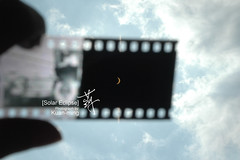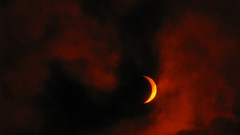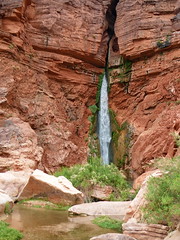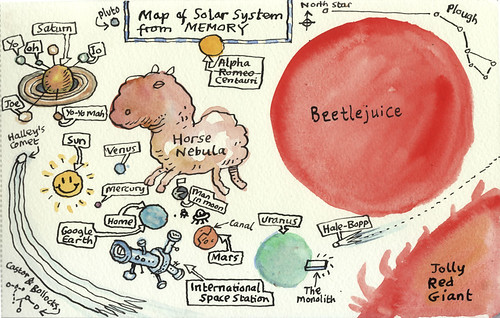Saturday, August 08, 2009
To the edge of space
This would have been a life-changing experience for me, too -- the black above, the curve of the earth below, all one planet.
On my first airplane trip, a 24-hour flight to Australia, back when it took that long and required one or two refueling stops, I awoke at one point to sunrise over the Pacific Ocean. The colors broke into a spectrum, a horizontal rainbow on the horizon between some towering clouds in the distance, and I nearly cried.
This was something my great-grandmother could never have had.
I wonder what the children coming after us will see.
Saturday, August 01, 2009
The more you know
"Are humans causing the climate to change/warm because of greenhouse gases and other anthropogenic activities?"

That's from @danwhnt, one of my favorite Twitter geonerds. (And it's much easier to read if you click through to the big one.)
I'm curious if so many non-experts believe climate change isn't largely anthropogenic because various media sources think they have to be balanced, and provide the viewpoint of one denier for every scientist who explains why humans provide a huge chunk of the fuel to drive climate change.
playing Ohio
In this flash application, Ohio's counties are given piano notes (which you can vary according to geographic data) and you can play songs, freeway routes, or other demographic data laid on top of that.
Ohio as a piano
In the two songs provided, I think the music might have been poorly transcribed, but there's only so much flash can do, right?
Friday, July 31, 2009
finding like minds
Anyone proudly using that one (or spreading geonerd jokes, and "you know you're a geonerd when....") is someone I'll probably enjoy getting to know.
Natural wonders
The youtube page says, "investigates unique deserts, coral reefs, waterfalls and other atypical natural phenomena." How are these atypical? I don't quite get it. Do they mean "special"? At any rate, these are neat, within a basic educational film.
oh the places you'll go

Mary Agnes Chase (1869-1963),
sitting at desk with specimens
Originally uploaded by Smithsonian Institution.
I'd gotten frustrated at my local community college for running out of classes I need to take, and want to take, this year. You see, I (*sigh*) procrastinated finishing my application for the local Cal State university geography program long enough that the state budget crisis interfered, and the university system decided not to admit any more applicants this school year for winter and spring quarters. This means I can't take classes, unless I'm willing to pay a lot for Open University classes (and there's room in them, unlikely given that cuts also reduced the total number of classes), until next fall.
So I'm trying to fill my year with classes that I don't need (as there are no more lower division classes that I need, period, ever) but that will be fascinating and most important, useful, both in my classes once I do get to the university, and in my career after that.
The community college where I'd been finishing geography (required) and astronomy (fun!) classes had run out of things for me. So I poked around.
And wow - it turns out another local community college has so many classes I could get a second AA (hush, I won't ... or will I?) before going on.
Check this out, classwise:
Environmental writing (I'm not sure if this is a study of environmental literature or learning how to write about it, and I don't care! Whee!)
Early childhood environmental education
Intro to creek watershed restoration
American Indian history and culture
Civilization's impact on the environment: psychology of trashing the earth
Environmental racism and justice
Natural History field classes (a few courses: local herpetology, local ornithology, Monterey Bay, Devil's Postpile)
Habitat Restoration Gardening
Wildlife and watershed
Contemporary Native Americans in the bay area
Permaculture design
I'm just blissed out, here. And that doesn't even count GIS and Spanish.
I can't take them all, but there are enough that I can fill my year with fun.
Wednesday, July 29, 2009
Remembering Apollo 1
On January 27, 1967, Apollo 1's crew--Virgil I. "Gus" Grissom, Edward H. White II and Roger B. Chaffee--was killed when a fire erupted in their capsule during testing. Apollo 1 was originally designated AS-204 but following the fire, the astronauts' widows requested that the mission be remembered as Apollo 1 and following missions would be numbered subsequent to the flight that never made it into space.
Wow.
That's lovely.
Saturday, July 25, 2009
Friday, July 24, 2009
obsessive geography brain

I was poking through Grant Imahara's stuff on Twitpic, and found this bridge photo. It's a "from the set" photo, so I assume it's in California, though it might not be. It has California native palms, though Washingtonia palms are used in landscaping so they're everywhere now. It's recent, so it's not the new Zampa bridge being built at Carquinez Strait, right? And it doesn't look like Carquinez Strait anyhow. Where are other steel truss bridges that high in California? What's going on behind it, are they working on a new bridge?
I'm going to poke around online until I find it or can't justify not getting up to plan for a trip we're headed out on soon. (I'll take pics, I could just turn Geographile into a vacation pictures journal. Wouldn't that be fun. :) )
In the meantime, if you know where this picture was taken, please let me know. This isn't a Mythbusters fan thing, it's a MUST KNOW GEOGRAPHY thing. It's an obsession. Clicking through on the picture will make it bigger for you.
(edited to add: Old span of Bay Bridge with new one under construction behind it. I see this a few times a week. But the scale seemed all wrong to me, this seemed much too small for it. Also, I didn't recognize the foreground, which is probably in Alameda or along the Oakland waterfront. Thanks to Paul and Bill for nudges.)
Edited again, July 24: DUH! Casey pointed out that I could have the direction completely wrong, and I did. Google maps confirms it's along Avenue N in the northeast corner of Treasure Island, in the middle of San Francisco Bay.
Wednesday, July 22, 2009
(maybe not) just one more
July 22th, 2009
Solar Eclipse
Taipei
Tuesday, July 21, 2009
Bring on the quakes

Click through to see the full size.
Yes, it's a lovely picture of totality, but so many of those show just the moon and corona and maybe a diamond ring.
But for this, having the boats in the foreground, and the clouds, and the slight texture of the water, make it truly amazing to me. This would be a fabulous print... at least, for nerds like me.
日蝕 Eclipse
So far, so good on the megadisaster. I found more than a few things on the web warning folks to stay off the beaches in India because of the potential for a massive quake in Japan that would somehow cause tsunamis in India.
There are total eclipses on this planet with relative regularity, and earthquakes every day, including a few large earthquakes every year.
My fingers are crossed that Asia won't coincidentally have a big quake in the next few hours, or we'll never hear the end of it from people who think the eclipse caused it.
On first seeing the Colorado River Basin
The upper two-thirds of the basin rises from four to eight thousand feet above the level of the sea. This high region, on the east, north, and west, is set with ranges of snow-clad mountains, attaining an altitude above the sea varying from eight to fourteen thousand feet. All winter long, on its monutain-crested rim, snow falls, filling the gorges, half burying the forests, and covering the crags and peaks with a mantle woven by the winds from the waves of the sea -- a mantle of snow. When the summer-sun comes, this snow melts, and tumbles down the mountain-sides in millions of cascades. Ten million cascade brooks unite to form ten thousand torrent creeks; ten thousand torrent creeks united to form a hundred rivers beset with cataracts; a hundred roaring rivers unite to form the Colorado, which rolls, a mad, turbid stream, into the Gulf of California
My battered copy of this book, which I bought for 25 cents from a box in front of a small used-bookstore, is one of the geographilic books I can just lie around and read bits of, over and over again.
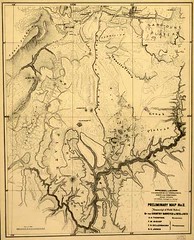
John Wesley Powell
 , with one arm, with food supplies that got wet and moldy over the weeks, with boats and crew gradually wearing out and falling apart, or leaving the party, made it, more than once, from one end of the Colorado to the other, and wrote richly about what he saw there.
, with one arm, with food supplies that got wet and moldy over the weeks, with boats and crew gradually wearing out and falling apart, or leaving the party, made it, more than once, from one end of the Colorado to the other, and wrote richly about what he saw there.





Of course, then we submerged many of his cataracts and fern-lined canyons with the reservoir that bears his name.

Monday, July 20, 2009
Thank God men cannot fly
Adventure for its own sake ... and for science
When I was a little girl, we would lie out in the back yard, or on the hood of the car, and stare at the moon, trying to see lunar landers. Mom never told us it was ridiculous for us to try to look, that we'd never see it. She never pretended she saw it, or tried to give us false hope. She just allowed it. She patiently listened as we came in to tell her our stories, sure we'd seen it. She ignored bedtimes, when Apollo missions were working. She made sure that we got to watch them on TV, every single time, every launch, every moon landing, every splashdown in the ocean at the end. It was part of the fabric of my childhood.
I hope we never stop adventuring for the sake of science ... for the sake of adventure, either. But for science.
This picture of Neil Armstrong after his first Apollo moonwalk, or EVA, on July 20, 1969, is one of my all-time favorite astronomy-related photos. Look at his face: It is glowing with rich delight.
(.... One small step for a man ....)
Sunday, July 19, 2009
name-dropping
He's truly and simply excited, and good at explaining the science he's researching in space, as well as other little things like "how do you eat peanut butter and honey in space?"
He's got a strong sense of wonder, and appreciates the question "what will happen if I do this?"
Dr. Pettit spoke at NASA Ames Moonfest, which is the main reason I went.
Some of my favorite questions from people at Moonfest:
"Can you see a solar eclipse from space?" from a kid. Pettit said it looked like illustrations in a textbook, with a visible umbra and penumbra on the ground, and yes, he's seen one.
One very young child asked, "How old do you have to be to go in space?" Pettit said that technically there's no lower age limit (upper either, for that matter) but that people should go to college, get a degree, then do something with it that shows NASA that you would be useful on their team. Most folks are within a few years of 40 when chosen. And he's going back in a couple of years, via Soyuz, to work on the ISS again.
One child asked, "if you sneeze in space is there just a glob of spit floating around?" There was much laughter. Pettit said that when you sneeze on the ISS or shuttle, you can just reach out and grab it with a dry wipe (I suppose that would be the glob, rather than the atomization), but inside a helmet, "You just have to live with the results."
Pettit also shared that they call the new toilet -> urine-processor -> galley setup the "coffee machine" as it turns yesterday's coffee into today's.
Robert Glennon on the water crisis
| The Daily Show With Jon Stewart | Mon - Thurs 11p / 10c | ||
| www.thedailyshow.com | |||
| |||
Thanks to Aquafornia for the link pointer.
(Perhaps we shouldn't be drinking from the toilets, but why not put a hand-wash basin on top of the toilet?)
Saturday, July 18, 2009
from the most trusted man in America
I am joining the hundreds of thousands who shall be marching in this virtual march to demonstrate the concern that we all hold for the future of our planet and all the living things -- flora, fauna, human and animal -- that exist upon it. The governments of the world have tarried long enough, and the United States is scarcely without doubt the greatest culprit among them.
We the people have the strength to bring our country from our weak-kneed stumbling gait in the last ranks of reason to the leadership of the great march to environmental victory.I want to be in that parade and if there is a place up front I'd wish to lead the band or at least be assigned a big bass drum to help pound out the rhythm of glorious success.
- Walter Cronkite
I will miss him.
Friday, July 17, 2009
still good with regard to madagascar

The BBC has an animated map showing the spread
of swine flu globally. Iceland, Fiji, Morocco ... it's getting around.
It's still not in Madagascar. It's just a matter of time....



